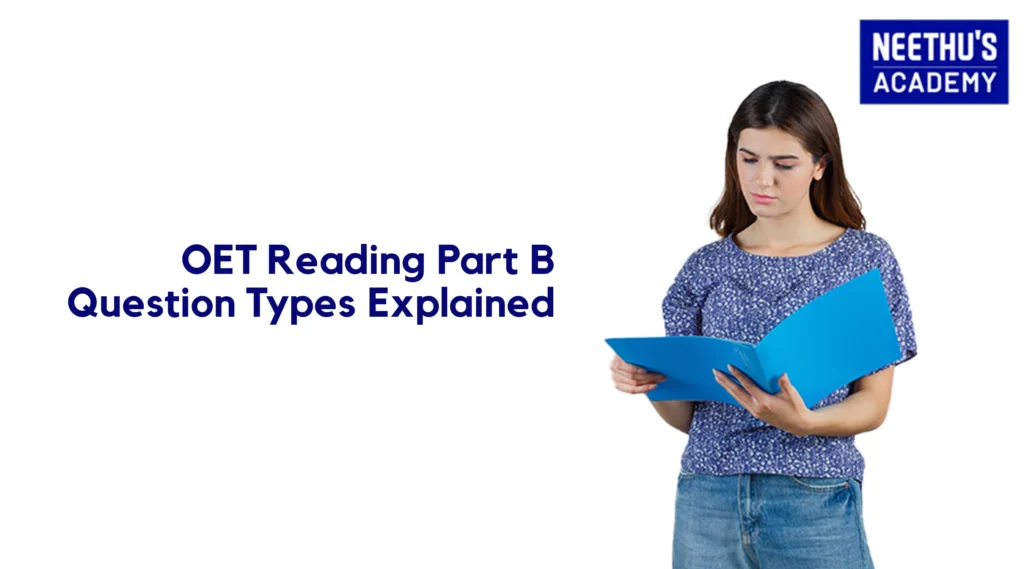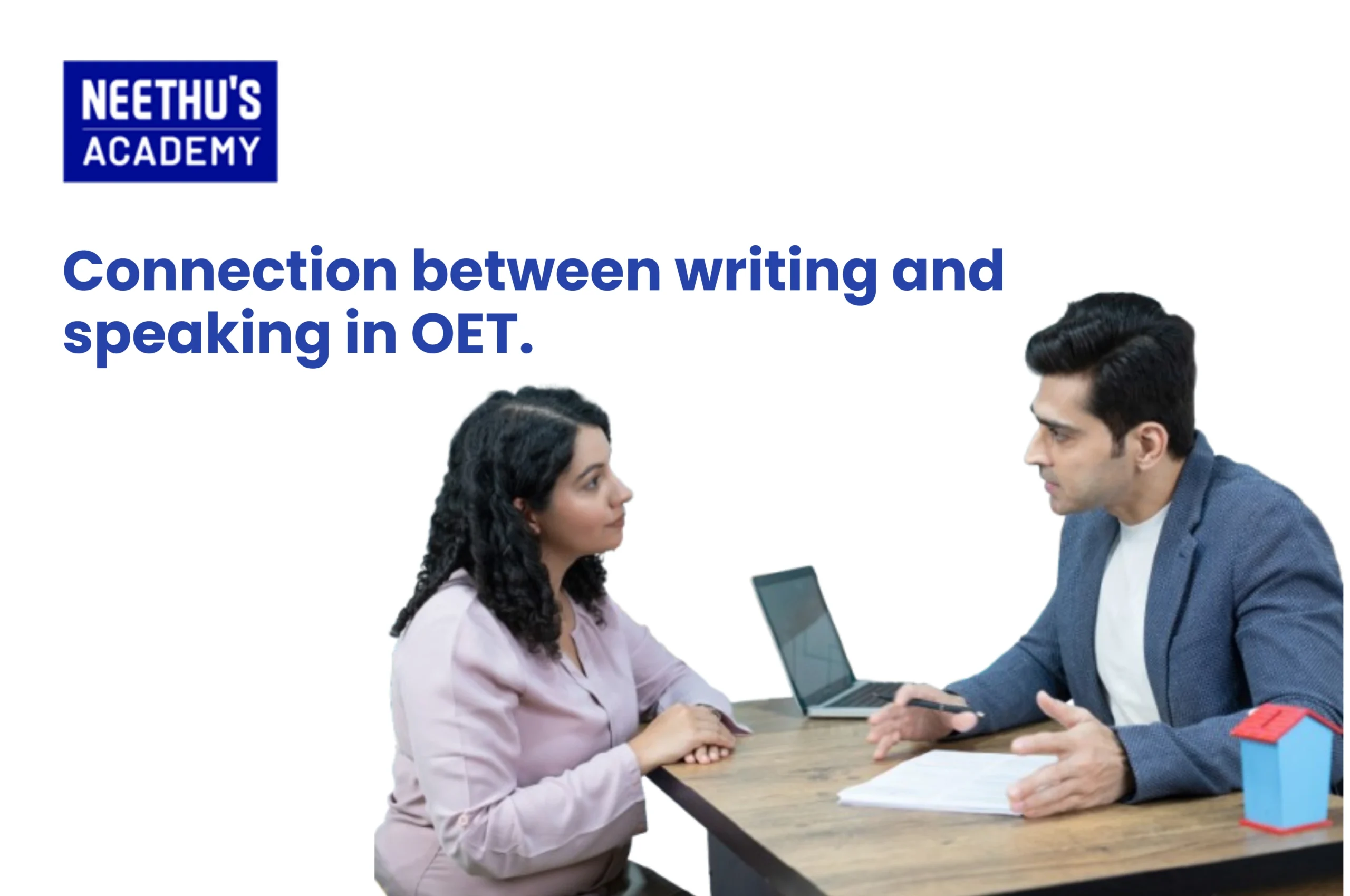Imagine you are running out of time and still have questions to complete! That would be the worst-case scenario while taking a…

OET Reading Part B Question Types Explained
The OET Reading section assesses whether or not a candidate can comprehend and evaluate healthcare-related texts. This is why OET Reading Part B is more vital—the way real-life workplace scenarios have students work with short texts such as memos, guidelines, and policy documents.
This blog shall detail the OET Reading Part B, the types of questions involved, and strategies and tips on how to do very well in this part. You can prepare through online classes about OET in Kerala or prepare self-paced, but you would still be using this as a roadmap.
Overview of OET Reading Part B
What is OET Reading Part B?
OET Reading Part B is one of three parts of the Reading sub-test and deals with six short texts relevant to healthcare workplaces. These may include:
Policy documents
Staff communications
Workplace guidelines
Notices or memos
For each text, candidates answer one multiple-choice question with three options (A, B, or C). The section tests the ability to:
Identify the purpose of the text
Understand specific details
Grasp the tone or intent of the writer
This part of the test aims to mimic real-life health care situations where rapid and effective understanding of documents is very important in patient care and communication.
Types of Questions for OET Reading Part B
OET Reading Part B Multiple-Choice Questions
There is only one type of question in Part B: multiple choice. The questions in this section test various aspects of text understanding and can be broadly classified into two broad categories:
Main Idea Questions: Focus on the big purpose or purpose of the text.
Detail-Oriented Questions: require locating information of specificity, steps for an instructional sequence, recommendations in guidelines
Questions to find the purpose of the Text
Text for which Purpose questions can assess your skills in making the inference like why a particular text was written. The answer options often reflect different purposes, such as:
To instruct or guide
To provide a directive and note changes in policy.
Warning or reminder
Example Question:
A memo with new infection control policies might contain:
What is the main purpose of this memo?
a) To notify of new patient admission
b) To notify of infection control updates
c) To report on an outbreak that has recently occurred
Specific Information
Detailed questions require the candidates to locate and interpret specific bits of information. These might include:
Steps in a process
Key terms of a policy
Specific instructions for staff
Sample Question:
A workplace policy on storing medication might question:
When the expiry date of the medicine cannot be explicitly observed, what should be done about it?
a) Give back to the supplier
b) Report it to the supervisor
c) Dispose of immediately
How to Answer OET Reading Part B Questions
Skim and Scan the Text
To answer questions properly, look quickly over the text to get the aim of the text. Scan for suitable words or phrases that answer the given question. For instance, use:
Skim the headline of the first sentence.
Scan for numbers, dates, or specific terms to find information.
Pay attention to Keywords
Keywords in the question and the choices given can also guide you to the correct portion of the text. For instance:
Words like “always,” “mandatory,” or “except” can help you narrow down.
Emphasize terms in the question that correspond to the text.
Get Rid of Obvious Wrong Answers
Get rid of any obviously wrong answers. To do this:
Compare each option with the text.
Rule out options that conflict with the information.
Watch out for absolute words (for example, “all,” “never”).
Practice Frequently
Frequent practice with OET Reading Part B sample questions will enhance your skills to recognize the patterns of question types and text structures. Take the advantage of practice material of OET training in Kerala or the available online resources.
OET Reading Part B Success Tips
Get Familiar with Context: Understand the healthcare-specific vocabulary and workplace scenarios in most texts for part B.
Manage Your Time Properly: Spend a given time on each question, maybe about 90 seconds.If unable to choose a correct answer, try your best to make a well-educated guess and proceed.
Pay Attention to Distractions Many multiple-choice questions include some distracters—the right sounding but unsupportable in the text. Careful reading should help avoid most of those traps.
Build Your Vocabulary: Expand your vocabulary on healthcare terms and expressions that can increase your understanding of texts.
Stay Calm Under Pressure: Focus and composure during the test are very important. Avoid overthinking and rely on your preparation.
Importance of OET Coaching for Reading Preparation
Benefits of OET Training in Kerala
Professional coaching offers one-to-one assistance and preparation that can be quite a boon for your performance in the OET. The following are the benefits:
In-depth knowledge: Learn from trainers who have a well-informed idea about requirements and strategies related to the OET.
Systemic Approach: Learn via a well-structured course or study plan that integrates each key aspect of the reading part B of OET.
Customized Feedback: Know your weak areas and work on your strength with detailed feedback.
Practice Tests and Practice Materials: Get practice tests that precisely resemble the real OET and access exclusive sample questions.
Flexibility in learning: Online classes in OET in Kerala allow flexibility to learn from home without compromising quality.
Peer learning: Interact with fellow candidates, and share strategies, and experiences.
By enrolling in OET training in Kerala, you earn the skills needed for an exam while also gaining self-confidence that you can do so.
How Practice Makes Perfect in the OET Reading Part B
Practice regularly is the key to mastering the OET Reading Part B. Here’s how it comes in handy:
Knowing Texts: Repetitive exposure to sample texts will help you have a faster understanding of key points.
Time Management: Practice helps you better utilize your time for questions.
Higher Accuracy: Mistakes, particularly in distractor identification, tend to decrease with increased practice.
Confidence Builder: Becoming accustomed to types of questions and tactics will build confidence at the actual time of the test.
The Bottom Line
OET Reading Part B is a critical section that assesses your ability to read workplace-related texts efficiently. Mastering the types of questions, strategies, and practice are all necessary steps to achieving success. Joining online OET classes in Kerala or taking OET training in Kerala can be the expert guidance and resources you need to shine.
This proper preparation will give you the success to confidently top the OET Reading Part B with confidence and to get that necessary score for advancing the careers of healthcare professionals. Do it now-invest in high-quality training and serious practice and unlock your potential.
Related Blogs
- All Posts
- OET
In case you are immigrating to Canada or looking for higher studies in the French-speaking parts of the nation, then the TCF…
Feeling a bit overwhelmed about the OSCE? You're not alone! The Objective Structured Clinical Examination is a big step in your medical…
Course Enquiry
Latest Posts
- All Posts
- canada
- CBT
- DHA
- French
- GENERAL
- German
- Haad
- IELTS
- IQN NEW ZEALAND
- MOH
- NCLEX-RN
- NHRA
- OET
- OSCE
- Pearson Vue
- PROMETRIC
- PTE
- TOEFL
- Back
- NCLEX - NGN
- Back
- OET FOR PHYSIOTHERAPIST
- OET FOR PHARMACIST
- OET FOR DOCTORS



Frequently Asked Questions
OET Reading Part B consists of six multiple-choice questions, each based on a short workplace-related text.
It comprises multiple-choice, matching, gap-fill, and short-answer questions in the four different sub-tests, namely listening, reading, writing, and speaking.
To score a B in OET Reading, one must understand text structures, practice regularly, and use the right strategies, such as skimming, scanning, and distractor elimination.
Solve OET Reading Part B by skimming for the main idea, scanning for keywords, eliminating incorrect options, and practicing extensively with sample texts.
